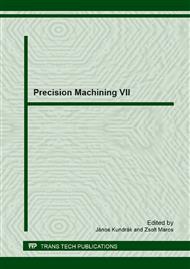[1]
T. Özel, Y. Karpat, and A. Srivastava, Hard turning with variable micro-geometry PcBN tools, Cirp Ann. - Manuf. Technol., vol. 57, no. 1, p.73–76, (2008).
DOI: 10.1016/j.cirp.2008.03.063
Google Scholar
[2]
F. Klocke and H. Kratz, Advanced Tool Edge Geometry for High Precision Hard Turning, Cirp Ann. - Manuf. Technol., vol. 54, no. 1, p.47–50, (2005).
DOI: 10.1016/s0007-8506(07)60046-8
Google Scholar
[3]
J. D. Thiele and S. N. Melkote, Effect of Tool Edge Geometry on Workpiece Subsurface Deformation and Through-Thickness Residual Stresses for Hard Turning of AISI 52100 Steel, J. Manuf. Process., vol. 2, no. 4, p.270–276, (2000).
DOI: 10.1016/s1526-6125(00)70028-4
Google Scholar
[4]
J. Hua, R. Shivpuri, X. Cheng, V. Bedekar, Y. Matsumoto, F. Hashimoto, and T. R. Watkins, Effect of feed rate, workpiece hardness and cutting edge on subsurface residual stress in the hard turning of bearing steel using chamfer + hone cutting edge geometry, Mater. Sci. Eng., vol. 394, no. 1–2, p.238–248, Mar. (2005).
DOI: 10.1016/j.msea.2004.11.011
Google Scholar
[5]
L. Chen, T. I. El-Wardany, M. Nasr, and M. A. Elbestawi, Effects of Edge Preparation and Feed when Hard Turning a Hot Work Die Steel with Polycrystalline Cubic Boron Nitride Tools, Cirp Ann. - Manuf. Technol., vol. 55, no. 1, p.89–92, (2006).
DOI: 10.1016/s0007-8506(07)60373-4
Google Scholar
[6]
D. Umbrello, J. Hua, and R. Shivpuri, Hardness-based flow stress and fracture models for numerical simulation of hard machining AISI 52100 bearing steel, Mater. Sci. Eng., vol. 374, no. 1–2, p.90–100, Június (2004).
DOI: 10.1016/j.msea.2004.01.012
Google Scholar
[7]
D. Umbrello, S. Rizzuti, J. C. Outeiro, R. Shivpuri, and R. M'Saoubi, Hardness-based flow stress for numerical simulation of hard machining AISI H13 tool steel, J. Mater. Process. Technol., vol. 199, no. 1–3, p.64–73, Apr. (2008).
DOI: 10.1016/j.jmatprotec.2007.08.018
Google Scholar


